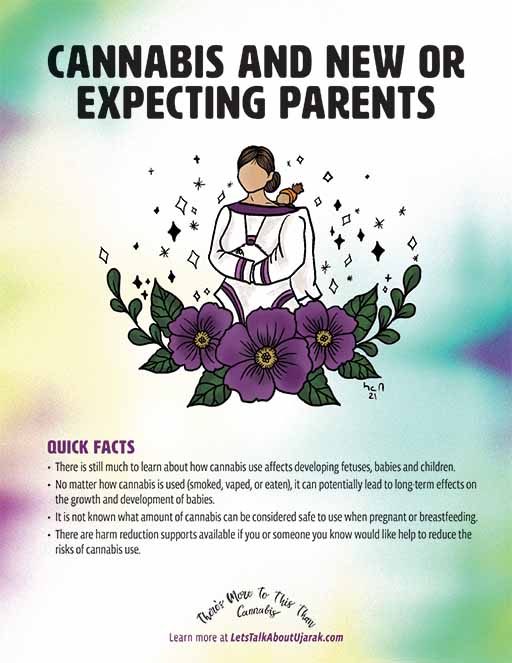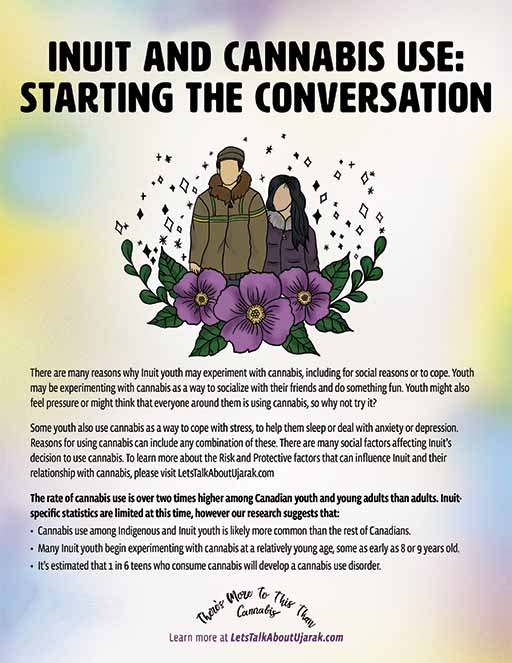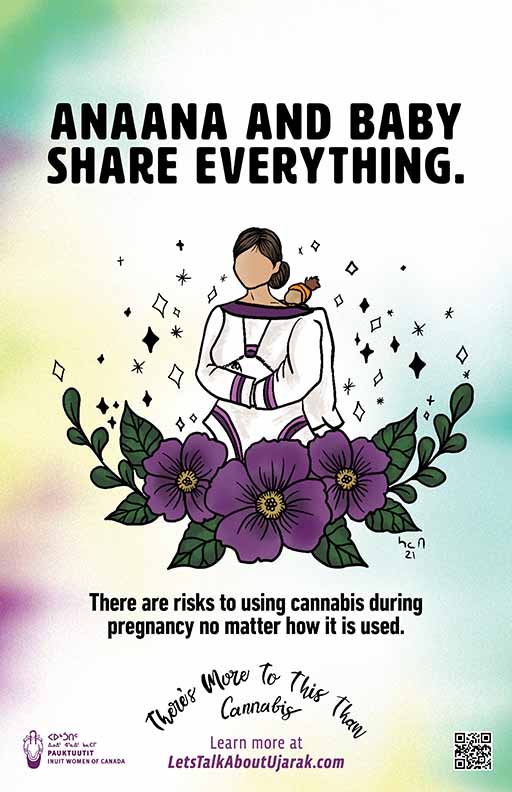There is still much to learn about how cannabis use affects developing fetuses, babies, and children. No matter how cannabis is used, it can potentially lead to long-term effects on the growth and development of babies. While it is not known what amount of cannabis can be considered safe to use when pregnant or breastfeeding, there are harm reduction supports available if you or someone you know would like help to reduce the risks of cannabis use.
Cannabis & Pregnancy
- Cannabis contains over 400 compounds which can pass from mother to baby.
- When a fetus is exposed to cannabis, the potential harms at birth can include a smaller baby with a low birth weight.
- While some mothers may choose to use cannabis to help with morning sickness (nausea), your Elder, health care provider, or community midwife can recommend other trusted options for coping with discomfort during pregnancy.
Cannabis & Child Development
There is some research suggesting that cannabis use during pregnancy can change the way a child grows and acts later in life. Potential behaviour and brain development challenges for children can include:
- Poor attention span
- Hyperactivity
- Poor memory
- Learning problems at school
Cannabis & Breastfeeding
- Breastfeeding is the best and most affordable way to feed your baby what it needs to grow and be healthy.
- Tetrahydrocannabinol (THC) from cannabis can pass into mothers’ breastmilk and be shared with the baby.
- Babies who are exposed to THC through breastmilk may become drowsy or have a hard time latching onto the breast.
Reducing the Risk - Harm reduction tips
- If you are having trouble becoming cannabis-free, try reducing the amount you use.
- Reduce how often you use. If you are using daily or near daily, try limiting when you use to certain days of the week.
- Try cannabis products that are lower in THC and higher in cannabidiol (CBD), which is the medicinal compound.
- Switch to edible cannabis products to avoid cannabis smoke. Cannabis smoke reduces the amount of oxygen going to the fetus and affects its development. However, keep in mind cannabis that is eaten can stay in your system longer.
- Use cannabis on its own rather than with other substances like tobacco, alcohol, or cocaine.
- If possible, try to avoid rooms where people are smoking cannabis or tobacco to avoid second-hand smoke.
- If smoking or vaping cannabis, avoid doing so near children or while carrying a child in an amauti.
- Clearly label and securely store any cannabis products in the home.
Being a Supportive Partner or Family Member
- Making a cannabis-free zone around pregnant and breastfeeding women can help reduce the temptation to use and prevent exposure to second hand smoke.
- Keep cannabis products and accessories (ash trays, lighters, pipes) out of sight as these can be triggers for use and pose dangers to young children in the home.
- Try to avoid smoking cannabis in the home while others are present (even out of a window), or on the porch near any open windows.
- Offer to go cannabis-free with your partner to help create a supportive and healthy environment.
- Focus on providing support in an open minded and non-judgemental way.
- Keep track of the money saved by cutting back or going cannabis-free, consider how this money could be put towards other uses such as a sewing machine or hunting supplies.
- Try to manage stress in the home by creating positive routines including a healthy diet and activities.
Factsheets and Posters
Fact Sheet available in:
English
Inuktitut
Inuinnaqtun
Inuttitut
Inuvialuktun
Nunavik
Discussion Guide available in:
English
Inuktitut
Inuinnaqtun
Inuttitut
Inuvialuktun
Nunavik
Poster available in:
English
Inuktitut
Inuinnaqtun
Inuttitut
Inuvialuktun
Nunavik



